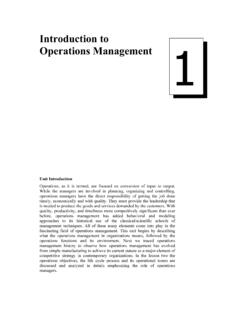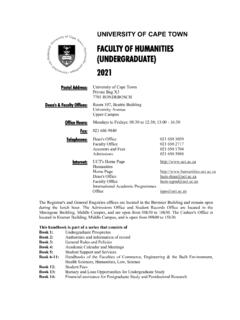Transcription of THEORIES OF ECONOMIC GROWTH - ebookbou.edu.bd
1 UNIT TWO. THEORIES OF ECONOMIC GROWTH . This unit discusses different GROWTH THEORIES and models since the classical heritage. The unit covers classical GROWTH THEORIES in lesson-1, Marx's model of capitalism in lesson-2, Schumpeter model on GROWTH , development and entepreneurship in lesson-3, Harrod-Domar GROWTH model in lesson-4, Kaldor-Mirrless (KM) model in lesson-5, neo- classical GROWTH model in lesson-6, the Dual Economy Model in lesson-7. and finally, endogenous GROWTH theory in lesson-8. School of Business Blank Page Unit-2 Page-20. Bangladesh Open University Lesson 1: Classical Heritage Objectives: GROWTH and development theory is at least as old as Adam Smith's famous book published in 1776 entitled An Inquiry into the Nature and Causes of the Wealth of Nations.
2 The macro issues of GROWTH , and the distribution of income between wages and profits, were the major preoccupation of all the great classical economists including Adam Smith, Thomas Malthus, John Stuart Mill, David Ricardo, and Karl Marx. As for the classical theory, excepting Marx, it can be spelt in terms of its key components that bear upon GROWTH , stationary state and the doctrine of laissez-faire. After studying this lesson, you will be able to;. Understand the basic features of the classical THEORIES of GROWTH Comprehend relevance of classical THEORIES in the context of developing countries. Introduction All classical economists were engaged in search for new analytical perspectives to explain GROWTH of countries.
3 Adam Smith gave the recognition that GROWTH can be generated in manufacturing as well as agriculture through expansion of markets, increased specialisation of function and spurts of scientific and technical advance. Considering natural resources main constraint, Ricardo showed that output expansion slows due to diminishing marginal productivity of labour on fixed land, implying that the most productive land is brought into cultivation first, then the lesser productive, and so on. The other main ingredient in the classical era is the Malthusian idea that population expands endogenously with output. Whenever output grows, population also ill expand until average consumption drops to the level of subsistence.
4 In other words, whenever an economy produces too much people ill procreate to expand their numbers until they revert to subsistence level (the level required for sheer physiological reproduction). According to Smith, The premium mobile of expanding national output and labour productivity is this same extension of the market. It is this which both makes GROWTH possible and simultaneously provides the necessary inducement not only to expand production, but to do so in a manner which increases labour productivity. Extension of the markets provides opportunities for an increase in the division of labour and division of labour raises labour productivity for three reasons: (a).
5 Workers become more efficient in the performance of particular tasks; (b). job specialisation reduces time spent switching tasks; (c) job specialisation also increases the scope for designing improved tools and machines to raise labour productivity. ECONOMIC Development and Planning Page-21. School of Business For another classical, Malthus, ECONOMIC GROWTH generates increased demand for labour and hence increases wages. Rising wages in turn led to an increase in population and hence labour supply: with an increase in living standards parents choose to have more children. In Principle of Population Malthus says: "Any rise in mass living standards could only be temporary because the increase in population would rapidly outstrip the capacity of the agriculture sector to meet the growing demand for food, for additional land brought into cultivation is generally less fertile then that already cultivated.
6 ". A Graphical Exposition of Classical Exposition of Classical GROWTH Theory ECONOMIC Demand for Wages Population Supply of Labour GROWTH Labour GROWTH A Simple Classical GROWTH Model The theory of GROWTH , as stated by the classical economists (Smith, Malthus, and Ricardo) can be described in a simple way1: According to labour THEORIES of value, wages will be paid to each worker according to the level of subsistence and surplus. The capitalists will accumulate surplus-the difference between total products and total consumption. The surplus is assumed to be equivalent of total wage bills. Such accumulation will increase the demand for labour and with a given population, wages will tend to rise.
7 As the wages exceeds the level of subsistence, the population will increase according to the Malthusian theory of population. Conversely, with a GROWTH of population, the supply of labour will be encouraged and wages will again fall back to the level of subsistence. But as wages become equal to the subsistence level, a surplus will emerge to encourage to accumulation and demand for labour. The whole process will be repeated again in the next phase. The dynamics of GROWTH ends as the law of diminishing returns sets in and wages eat up the whole production leaving no surplus for accumulation, expansion and GROWTH population.
8 The vertical axis measures total production minus rent and the horizontal axis measures employment of labour. The line OW indicates the subsistence wage line. With ON1 population, production is OP, wage per unit is N1 W1 and surplus or profit is El W1 when TP (total production) is the sum of wages and profits. The emergence of surplus engenders accumulation which leads to an increase in the demand for labour. Wages rise to E1N1 since the demand for labour rises with accumulation but population, and therefore labour supply, remains constant at ON1 But once the wages are above the level of subsistence, El N I > N I W1, GROWTH of population is stimulated to ON2.
9 1. Based on Subrata Ghatak An International to Development Economics, London: Allen and Unwin,1986. Unit-2 Page-22. Bangladesh Open University W. TP/. E TP. Total Production E2. P. E1 W2. W1. O N1 N2 Labour Figure : Once the population is ON2, a 'surplus' emerges again, E2 W1 as wages are driven back to the level of subsistence and the whole process is repeated until the economy reaches a point like E where the 'stationary state' is attained. As wages are equal to production, there is no surplus. If technical progress2 is introduced (a shift of TP to TP') then note that the point (wages = production) is only postponed, but not eliminated.
10 An Evaluation One of Smith's most important contributions was to introduce into economics the notion of increasing returns a concept that new' GROWTH theory (or endogenous GROWTH theory) has recently rediscovered. In Smith, increasing returns is based on the division of labour. He saw the division of labour, or gains from specialisation, as the very basis of a social economy, otherwise everybody might as well be their own Robinson Crusoe doing everything for themselves. And it is the notion of increasing returns, based on the division of labour, that lay at the heart of Smith's optimistic vision of ECONOMIC progress as a self-generating process, in contrast to the later classical economists, such as Ricardo and 2.

















